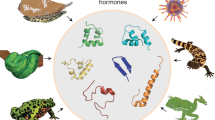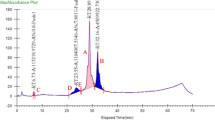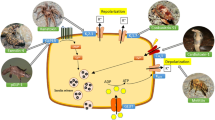Abstract
Glucose-induced insulin secretion is a cardinal process in glucose homeostasis and metabolic expenditure. Uncoupling of the insulin response to glucose variations may lead to type-2 diabetes mellitus. Thus the identification of more specific drugs to facilitate the study of insulin secretion mechanisms and to develop new pharmacological agents for therapeutics is fundamental. Venomous organisms possess a great diversity of toxic molecules and some of them are neurotoxins that affect membrane excitability. This article reviews properties of those toxins affecting ion channels pivotal for insulin secretion and the usefulness of such compounds in the study of pancreatic beta-cell physiology. Here we examine the major contributions of toxinology to the understanding of the ionic phase of insulin secretion, to the determination of ion channel composition in different insulin secreting cell-line models as well as from primary cultures of different mammal species. Finally, we present a summary of the many diverse toxins affecting insulin release and a brief discussion of the potential of novel toxins in therapeutics.


Similar content being viewed by others
References
Aicardi G, Pollo A, Sher E, Carbone E (1991) Noradrenergic inhibition and voltage-dependent facilitation of omega-conotoxin-sensitive Ca channels in insulin-secreting RINm5F cells. FEBS Lett 281:201–204
Akiba Y, Kato S, Katsube K, Nakamura M, Takeuchi K, Ishii H, Hibi T (2004) Transient receptor potential vanilloid subfamily 1 expressed in pancreatic islet beta cells modulates insulin secretion in rats. Biochem Biophys Res Commun 321:219–225
Alevizos A, Mihas C, Mariolis A (2007) Insulin secretion and capsaicin. Am J Clin Nutr 85:1165–1166
Andreev YA, Kozlov SA, Koshelev SG, Ivanova EA, Monastyrnaya MM, Kozlovskaya EP, Grishin EV (2008) Analgesic compound from sea anemone Heteractis crispa is the first polypeptide inhibitor of vanilloid receptor 1 (TRPV1). J Biol Chem 283:23914–23921
Braun M, Ramracheya R, Bengtsson M, Zhang Q, Karanauskaite J, Partridge C, Johnson PR, Rorsman P (2008) Voltage-gated ion channels in human pancreatic beta-cells: electrophysiological characterization and role in insulin secretion. Diabetes 57:1618–1628
Castañeda O, Sotolongo V, Amor AM, Stöcklin R, Anderson AJ, Harvey AL, Engström A, Wernstedt C, Karlsson E (1995) Characterization of a potassium channel toxin from the Caribbean Sea anemone Stichodactyla helianthus. Toxicon 33:603–613
Cawthorn EG, Chan CB (1991) Effect of pertussis toxin on islet insulin secretion in obese (fa/fa) Zucker rats. Mol Cell Endocrinol 75:197–204
Cromer BA, McIntyre P (2008) Painful toxins acting at TRPV1. Toxicon 51:163–173
Cruz-Cruz R, Salgado A, Sánchez-Soto C, Vaca L, Hiriart M (2005) Thapsigargin-sensitive cationic current leads to membrane depolarization, calcium entry, and insulin secretion in rat pancreatic beta-cells. Am J Physiol Endocrinol Metab 289:E439–E445
Cuypers E, Yanagihara A, Karlsson E, Tytgat J (2006) Jellyfish and other cnidarian envenomations cause pain by affecting TRPV1 channels. FEBS Lett 580:5728–5732
Dutertre S, Lewis RJ (2010) Use of venom peptides to probe ion channel structure and function. J Biol Chem 285:13315–13320
Ernst SJ, Aguilar-Bryan L, Noebels JL (2009) Sodium channel beta1 regulatory subunit deficiency reduces pancreatic islet glucose-stimulated insulin and glucagon secretion. Endocrinology 150:1132–1139
Gonçalves AA, Toyama MH, Carneiro EM, Marangoni S, Arantes EC, Giglio JR, Boschero AC (2003) Participation of Na(+) channels in the potentiation by Tityus serrulatus alpha-toxin TsTx-V of glucose-induced electrical activity and insulin secretion in rodent islet beta-cells. Toxicon 41:1039–1045
Herrington J (2007) Gating modifier peptides as probes of pancreatic beta-cell physiology. Toxicon 49:231–238
Herrington J, Sanchez M, Wunderler D, Yan L, Bugianesi RM, Dick IE, Clark SA, Brochu RM, Priest BT, Kohler MG, McManus OB (2005) Biophysical and pharmacological properties of the voltage-gated potassium current of human pancreatic beta-cells. J Physiol 567:159–175
Herrington J, Zhou YP, Bugianesi RM, Dulski PM, Feng Y, Warren VA, Smith MM, Kohler MG, Garsky VM, Sanchez M, Wagner M, Raphaelli K, Banerjee P, Ahaghotu C, Wunderler D, Priest BT, Mehl JT, Garcia ML, McManus OB, Kaczorowski GJ, Slaughter RS (2006) Blockers of the delayed-rectifier potassium current in pancreatic beta-cells enhance glucose-dependent insulin secretion. Diabetes 55:1034–1042
Hillaire-Buys D, Gross R, Roye M, Ribes G, Loubatières-Mariani MM (1992) Adrenergic inhibition of insulin secretion involves pertussis toxin-sensitive and -insensitive mechanisms. Eur J Pharmacol 218:359–362
Hiriart M, Aguilar-Bryan L (2008) Channel regulation of glucose sensing in the pancreatic beta-cell. Am J Physiol Endocrinol Metab 295:E1298–E1306
Hiriart M, Matteson DR (1988) Na channels and two types of Ca channels in rat pancreatic B cells identified with the reverse hemolytic plaque assay. J Gen Physiol 91:617–639
Hiriart M, Ramirez-Medeles MC (1993) Muscarinic modulation of insulin secretion by single pancreatic beta-cells. Mol Cell Endocrinol 93:63–69
Hlubek MD, Stuenkel EL, Krasnoperov VG, Petrenko AG, Holz RW (2000) Calcium-independent receptor for α-latrotoxin and neurexin 1α facilitate toxin-induced channel formation: evidence that channel formation results from tethering of toxin to membrane. Mol Pharmacol 57:519–528
Holz GG, Habener JF (1998) Black widow spider alpha-latrotoxin: a presynaptic neurotoxin that shares structural homology with the glucagon-like peptide-1 family of insulin secretagogic hormones. Comp Biochem Physiol B 21:177–184
Holz GG, Leech CA, Habener JF (2000) Insulinotropic toxins as molecular probes for analysis of glucagon-like peptide-1 receptor-mediated signal transduction in pancreatic beta-cells. Biochimie 82:915–926
Iwanir S, Reuveny E (2008) Adrenaline-induced hyperpolarization of mouse pancreatic islet cells is mediated by G protein-gated inwardly rectifying potassium (GIRK) channels. Pflugers Arch 456:1097–1108
Kanjhan R, Coulson EJ, Adams DJ, Bellingham MC (2005) Tertiapin-Q blocks recombinant and native large conductance K+ channels in a use-dependent manner. J Pharmacol Exp Ther 314:1353–1361
Krasnoperov V, Bittner MA, Mo W, Buryanovsky L, Neubert TA, Holz RW, Ichtchenko K, Petrenko AG (2002) Protein-tyrosine phosphatase-σ is a novel member of the functional family of α-latrotoxin receptors. J Biol Chem 227:35887–35895
Lang J, Ushkaryov Y, Grasso A, Wollheim CB (1998) Ca2+-independent insulin exocytosis induced by alpha-latrotoxin requires latrophilin a G protein-coupled receptor. EMBO J 17:648–657
Laure CJ (1975) The primary structure of crotamine. Hoppe Seylers Z Physiol Chem 356:213–215
Leech CA, Habener JF (1997) Insulinotropic glucagon-like peptide-1-mediated activation of non-selective cation currents in insulinoma cells is mimicked by maitotoxin. J Biol Chem 272:17987–17993
Matavel AC, Ferreira-Alves DL, Beirão PS, Cruz JS (1998) Tension generation and increase in voltage-activated Na+ current by crotamine. Eur J Pharmacol 348:167–173
Pace CS (1979) Activation of Na channels in islet cells: metabolic and secretory effects. Am J Physiol 237:E130–E135
Philipson LH, Kusnetsov A, Larson T, Zeng Y, Westermark G (1993) Human, rodent, and canine pancreatic beta-cells express a sodium channel alpha 1-subunit related to a fetal brain isoform. Diabetes 42:1372–1377
Plant TD (1988) Na+ currents in cultured mouse pancreatic B-cells. Pflugers Arch 411:429–435
Pressel DM, Misler S (1990) Sodium channels contribute to action potential generation in canine and human pancreatic islet B cells. J Membr Biol 116:273–280
Roe MW, Lancaster ME, Mertz RJ, Worley JF III, Dukes ID (1993) Voltage-dependent intracellular calcium release from mouse islets stimulated by glucose. J Biol Chem 268:9953–9956
Roe MW, Worley JF III, Quian F, Tamarina N, Mittal AA, Drayluk F, Blair RJ, Philipson LH, Dukes I (1998) Characterization of a Ca2+ release-activated nonselective cation current regulating membrane potential and [Ca2+]i oscillations in transgenically derived beta-cells. J Biol Chem 273:10402–10410
Rosenbaum T, Vidaltamayo R, Sánchez-Soto MC, Zentella A, Hiriart M (1998) Pancreatic beta cells synthesize and secrete nerve growth factor. Proc Natl Acad Sci 95:7784–7788
Rosenbaum T, Sánchez-Soto MC, Hiriart M (2001) Nerve growth factor increases insulin secretion and barium current in pancreatic beta-cells. Diabetes 50:1755–1762
Salazar H, Jara-Oseguera A, Rosenbaum T (2009) The TRPV1 channel as a target for the treatment of pain. Rev Neurol 48:357–364
Sher E, Biancardi E, Pollo A, Carbone E, Li G, Wollheim CB, Clementi F (1992) omega-Conotoxin-sensitive, voltage-operated Ca2+ channels in insulin-secreting cells. Eur J Pharmacol 216:407–414
Siemens J, Zhou S, Piskorowski R, Nikai T, Lumpkin EA, Basbaum AI, King D, Julius D (2006) Spider toxins activate the capsaicin receptor to produce inflammatory pain. Nature 444:208–212
Swartz KJ (2007) Tarantula toxins interacting whit voltage sensors in potassium channels. Toxicon 49:213–230
Swartz KJ, MacKinnon R (1995) An inhibitor of the Kv2.1 potassium channel isolated from the venom of a Chilean tarantula. Neuron 15:941–949
Takasawa S, Nata K, Yonekura H, Okamoto H (1993) Cyclic ADP-ribose in insulin secretion from pancreatic beta cells. Science 259:370–373
Tamarina NA, Kuznetsov A, Fridlyand LE, Philipson LH (2005) Delayed-rectifier (KV2.1) regulation of pancreatic beta-cell calcium responses to glucose: inhibitor specificity and modeling. Am J Physiol Endocrinol Metab 289:E578–E585
Toyama MH, Carneiro EM, Marangoni S, Barbosa RL, Corso G, Boschero AC (2000) Biochemical characterization of two crotamine isoforms isolated by a single step RP-HPLC from Crotalus durissus terrificus (South American rattlesnake) venom and their action on insulin secretion by pancreatic islets. Biochim Biophys Acta 1474:56–60
Ushkaryov YA, Rohou A, Sugita S (2008) Α-Latrotoxin and its receptors. Handb Exp Pharmacol 184:171–206
Worley JF III, McIntyre MS, Spencer B, Dukes ID (1994) Depletion of intracellular Ca2+ stores activates a maitotoxin-sensitive nonselective cationic current in beta-cells. J Biol Chem 269:32055–32058
Yuan C, Yang S, Liao Z, Liang S (2007) Effects and mechanism of Chinese tarantula toxins on the Kv2.1 potassium channels. Biochem Biophys Res Commun 352:799–804
Acknowledgments
We are grateful to, Dr. Tamara Rosenbaum for reading and discussing the manuscript. To Ana María Escalante Gonzalbo and Francisco Pérez Eugenio, from the Computer Unit and Felix Sierra, for excellent technical support. All from the Instituto de Fisiología Celular, Universidad Nacional Autónoma de México, UNAM. This work was supported by Gobierno del Distrito Federal PICDS08-72, CONACYT FI 60065, DGAPA-PAPIIT 229407, and SDI.PTID. 05.6 Facultad de Medicina Universidad Nacional Autónoma de México. Carlos Manlio Díaz García received scholar grants from Doctorado Conjunto en Ciencias Biológicas UNAM-UH, Red de Macro Universidades de América Latina y el Caribe and Gobierno del Distrito Federal PICDS08-72.
Author information
Authors and Affiliations
Corresponding author
Additional information
A commentary to this article can be found at doi:10.1007/s10571-010-9611-z
Rights and permissions
About this article
Cite this article
Diaz-Garcia, C.M., Sanchez-Soto, C. & Hiriart, M. Toxins that Modulate Ionic Channels as Tools for Exploring Insulin Secretion. Cell Mol Neurobiol 30, 1275–1281 (2010). https://doi.org/10.1007/s10571-010-9586-9
Received:
Accepted:
Published:
Issue Date:
DOI: https://doi.org/10.1007/s10571-010-9586-9




